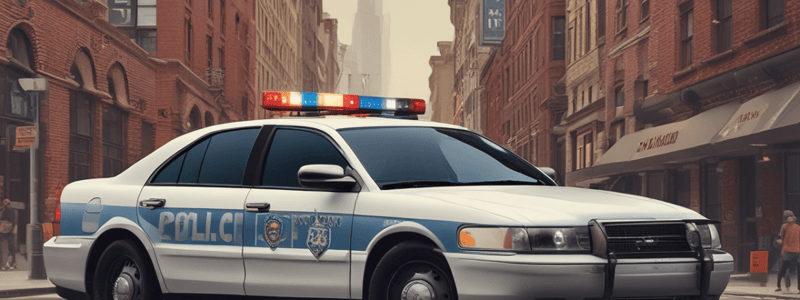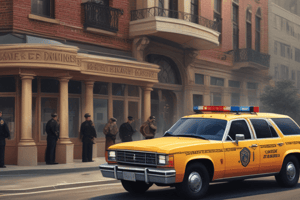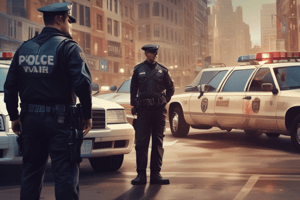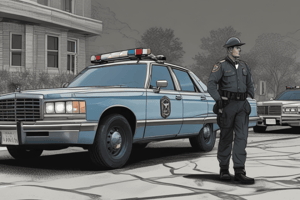Podcast
Questions and Answers
According to the directive, when are members allowed to use seat belts when operating or riding as a passenger in any department vehicle?
According to the directive, when are members allowed to use seat belts when operating or riding as a passenger in any department vehicle?
- Only when responding to emergency calls
- When operating Code One
- When operating at high speeds
- When in any department vehicle (correct)
A pursuit can be initiated for a serious traffic violation like DUI or a stolen auto.
A pursuit can be initiated for a serious traffic violation like DUI or a stolen auto.
False (B)
Tactical Vehicle Intervention (TVI) is a car to car contact technique designed to __________ another vehicle.
Tactical Vehicle Intervention (TVI) is a car to car contact technique designed to __________ another vehicle.
disable
Match the following pursuit vehicles with their roles:
Match the following pursuit vehicles with their roles:
What is the primary purpose of monitoring the progress of a pursuit?
What is the primary purpose of monitoring the progress of a pursuit?
Which vehicles are tire deflation devices NOT used on?
Which vehicles are tire deflation devices NOT used on?
During tire deflation device deployment, the police vehicle can be used to block the path of the suspect.
During tire deflation device deployment, the police vehicle can be used to block the path of the suspect.
What should members do to the tire deflation devices if the devices are deployed but not used in wet weather?
What should members do to the tire deflation devices if the devices are deployed but not used in wet weather?
Where is the serial number located on the Stop Stick?
Where is the serial number located on the Stop Stick?
Who is authorized to give approval for implementing the Tactical Vehicle Intervention (TVI) technique?
Who is authorized to give approval for implementing the Tactical Vehicle Intervention (TVI) technique?
Members who have not been trained to use the TVI technique should take over as the primary pursuit vehicle position.
Members who have not been trained to use the TVI technique should take over as the primary pursuit vehicle position.
The TVI technique may be used to stop and apprehend violent felony offenders whose actions indicate a disregard for the safety of the public and members. Trained members will use the _______ standard for all deployments.
The TVI technique may be used to stop and apprehend violent felony offenders whose actions indicate a disregard for the safety of the public and members. Trained members will use the _______ standard for all deployments.
Match the following regarding TVI with their corresponding description:
Match the following regarding TVI with their corresponding description:
What factors should be considered before and during a pursuit to determine if it should be initiated, continued, or terminated?
What factors should be considered before and during a pursuit to determine if it should be initiated, continued, or terminated?
An unmarked police car can engage in a pursuit without specific approval under certain circumstances.
An unmarked police car can engage in a pursuit without specific approval under certain circumstances.
What immediate action should the Primary Vehicle Member take when attempting to stop a vehicle that refuses to stop?
What immediate action should the Primary Vehicle Member take when attempting to stop a vehicle that refuses to stop?
A pursuit should be terminated when the danger to the public or member created by the pursuit exceeds the danger presented by the offender ________ at large.
A pursuit should be terminated when the danger to the public or member created by the pursuit exceeds the danger presented by the offender ________ at large.
Match the following responsibilities with their corresponding roles during a police vehicle pursuit:
Match the following responsibilities with their corresponding roles during a police vehicle pursuit:
Flashcards are hidden until you start studying
Study Notes
Kansas City, Missouri Police Department Procedural Instruction
Introduction
- This written directive sets parameters for vehicle pursuits, emergency police vehicle operations, tire deflation devices, and Tactical Vehicle Intervention (TVI)
Guidelines
- Members must abide by city traffic ordinances and state motor vehicle laws and regulations, unless operating Code One
- Seat belts must be worn by members operating or riding as passengers in department vehicles
- Members must ensure that all passengers use seatbelts or other appropriate restraint devices
- Vehicle pursuits are only permitted for dangerous felonies, DUI, or stolen autos where the suspect presents a clear and immediate danger to others
- Pursuits against traffic flow on divided highways are prohibited without prior approval from a supervisor/commander
- Stationary and rolling roadblocks are prohibited, except as outlined in Annex E
- Push-bumpers are prohibited in pursuits, except as outlined in Annex E
- TVI technique may be used by trained members assigned to Tactical Response Teams and Street Crimes Unit Tactical Response Teams
Terminology
- Controlling Supervisor/Commander: assumes verbal control of the pursuit
- Dangerous Felony: felony involving actual or threatened attack that could result in death or serious bodily injury
- Emergency: reasonable belief that a crime is about to be committed, is being committed, or has been committed, involving injury or threat of injury
- Emergency Operation/Code One: emergency police vehicle traveling with activated red light(s) and siren
- Emergency Police Vehicle: police vehicle equipped with a siren and one or more red light(s)
- Momentary Activation: brief activation of red lights and/or siren to gain the driver's attention
- Paralleling: operation of police vehicles parallel to the pursuit route, operating in a Code One capacity
- Pursuit: event where a member attempts to stop a vehicle, and the driver refuses to stop or tries to avoid capture
- Pursuit Police Vehicle: police vehicle involved in a pursuit, categorized as primary, secondary, or other
- Pursuit Rated: vehicle or motorcycle certified for law enforcement use, equipped with emergency lights and sirens
- Roadblock: restriction or obstruction to prevent free passage of a motor vehicle, intended to apprehend a pursued vehicle
- Significant Passage of Time: period where a vehicle or person goes out of sight, but is not considered lost contact
- Tactical Vehicle Intervention (TVI): car-to-car contact technique to disable a vehicle, designed to intervene and de-escalate situations
- Terminate: pursuits may be terminated by the pursuing member, by order of a supervisor/commander, or when the suspect vehicle stops
- Tire Deflation Device: manually deployed device with hollow steel spikes to rapidly deflate a vehicle tire
- Uncontrolled Intersection: intersection without traffic control
Police Vehicle Emergency Operation (Other Than Pursuits)
- Members will drive with due regard for safety, considering the urgency of the situation, weather, visibility, and other factors
- Code One operation will be used in situations where it is necessary to preserve life, prevent serious personal injury, or protect property in immediate danger of destruction
- Members will approach intersections with caution, clearing the intersection before proceeding
- The siren will be used in addition to red lights if necessary to gain attention, and members will yield to ambulances and fire equipment
Police Vehicle Pursuit Procedure
-
Factors to consider before and during a pursuit include the seriousness of the violation, weather, road conditions, traffic, and the safety of the public and members
-
Pursuits will not be initiated unless the suspect presents a clear and immediate danger to others
-
Code One Operation will be used throughout the pursuit
-
The decision to initiate or continue a pursuit will be based on factors known to the member at the time, and will be continually evaluated during the pursuit
-
A pursuit will be terminated when the danger to the public or member created by the pursuit exceeds the danger presented by the offender remaining at large, or when ordered by a supervisor/commander### Vehicle Pursuit Policy
-
The policy outlines the procedures for police vehicle pursuits, ensuring public safety and officer safety.
Initiation of Pursuit
- A police officer can initiate a pursuit when they have a reasonable suspicion of a crime or a traffic violation.
- The officer must consider the risk to the public and the importance of apprehending the suspect.
Primary Vehicle Member's Responsibilities
- The primary vehicle member is responsible for:
- Initiating the pursuit and assuming the primary pursuit vehicle position.
- Activating the in-car camera and audio, if available.
- Transmitting the location, speed, traffic density, and driving demeanor of the pursued vehicle every two blocks or when the vehicle changes direction.
- Continually evaluating the need to apprehend the suspect against the risk to the public.
Secondary Vehicle Member's Responsibilities
- The secondary vehicle member is responsible for:
- Activating the red light and siren.
- Maintaining a safe distance behind the primary vehicle.
- Assisting the primary vehicle during the pursuit and at the point of termination.
- Being prepared to assume the role of the primary vehicle if needed.
Other Vehicle Members' Responsibilities
- Other vehicle members are responsible for:
- Operating Code One when given permission by a supervisor/commander.
- Providing traffic control or deploying a tire deflation device.
Communications/Dispatcher Responsibilities
- The dispatcher is responsible for:
- Notifying all members of the pursuit and obtaining the location, direction, and description of the pursued vehicle.
- Relaying additional pursuit information as necessary.
- Assigning a secondary vehicle and notifying the controlling supervisor/commander.
- Notifying other divisions and jurisdictions affected by the pursuit.
Helicopter Section's Responsibilities
- The helicopter section is responsible for:
- Assisting in the pursuit and assuming responsibility as the main pursuit vehicle.
- Advising the dispatcher of the pursuit location and direction.
- Terminating the pursuit if the helicopter's presence escalates the pursuit or poses a danger to the public.
Controlling Supervisor's/Commander's Responsibilities
- The controlling supervisor/commander is responsible for:
- Obtaining information about the pursuit and evaluating the circumstances.
- Making the decision to continue or terminate the pursuit.
- Moving to the pursuit location and responding to the termination point.
- Completing a Patrol Bureau Report (PBR) prior to the end of the shift.
Police Vehicle Pursuits Involving Other Jurisdictions
- Members must not engage in a pursuit initiated by an outside agency without authorization from a supervisor/commander.
- The supervisor/commander who authorizes a member to engage in a pursuit will assume the responsibilities of the controlling supervisor/commander.
Tire Deflation Device
- The tire deflation device is a tool used to safely deflate a vehicle's tires during a pursuit.
- The device is made of a water-resistant, laminated paperboard housing with three rows of twelve quills.
- Each quill has a Teflon-coated steel spike that pierces the tire and causes a controlled deflation.
Deployment of Tire Deflation Device
- The device can only be used on four-wheeled vehicles and will not be used on vehicles transporting hazardous materials or passengers.
- The device will not be deployed in locations that pose a risk to other traffic.
- Members must deploy the device in a safe and controlled manner, taking into account the location and circumstances of the pursuit.
Reporting Requirements
- Information regarding damages incurred due to the tire deflation device will be included in the report.
- A separate form will be completed for any damages or injuries sustained during the pursuit.
Tactical Vehicle Intervention (TVI)
- TVI is a technique used to stop and apprehend violent felony offenders.
- Only trained members of the Tactical Response Teams and Street Crimes Unit may use the TVI technique.
- The TVI technique may be used to stop and apprehend suspects who pose a danger to the public and members.
Studying That Suits You
Use AI to generate personalized quizzes and flashcards to suit your learning preferences.




